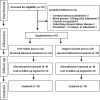0.9% Saline versus Ringer's lactate as initial fluid in children with diabetic ketoacidosis: a double-blind randomized controlled trial
- PMID: 40194836
- PMCID: PMC11977471
- DOI: 10.1136/bmjdrc-2024-004623
0.9% Saline versus Ringer's lactate as initial fluid in children with diabetic ketoacidosis: a double-blind randomized controlled trial
Abstract
Introduction: Ringer's lactate (RL), a balanced crystalloid by regenerating bicarbonate ion, may lead to early diabetic ketoacidosis (DKA) resolution and reduced hyperchloremia as compared with 0.9% saline (NS).
Research design and methods: This was a double-blind randomized controlled trial conducted in the pediatric emergency and intensive care units of a teaching hospital. Children with type 1 diabetes mellitus (T1DM) aged 9 months to 12 years who presented in DKA were included. Participants were randomized to receive either NS or RL as initial fluid (used for both resuscitation and replacement). The primary outcome was time to resolution of DKA. Secondary outcomes included change in serum chloride and bicarbonate from baseline, total fluid received and incidence of acute kidney injury.
Results: The study was conducted between December 2020 and December 2021, and 67 children were recruited (34 in the NS group and 33 in the RL group). The mean time to DKA resolution was shorter in the RL group compared with the NS group (12.9±7.9 vs 16.8±9 hours). The mean difference and HR for time to DKA resolution in the RL group compared with the NS group were 3.85 hours (95% CI 0.3 to 8) and 1.39 hours (95% CI 1.25 to 1.56), respectively. The rise in chloride from baseline was higher in the NS group as compared with the RL group at 4 and 8 hours (8.7±5.6 vs 3.9±5.1 mmol/L) and (10.8±7.7 vs 4.4±8.3 mmol/L), respectively. On the contrary, the rise in bicarbonate from baseline to 12 hours was significantly higher in the RL group as compared with the NS group (14.7±1.6 vs 12.9±3.1).
Conclusions: The time to resolution of DKA was shorter in RL group as compared with the NS group. Regeneration of bicarbonate from lactate ion in the RL forms a strong physiological basis for this outcome as compared with hyperchloremia induced by NS. This makes RL a favorable option in children with DKA.
Keywords: Child; Child Health; Diabetes Complications; Diabetic Ketoacidosis.
© Author(s) (or their employer(s)) 2025. Re-use permitted under CC BY-NC. No commercial re-use. See rights and permissions. Published by BMJ Group.
Conflict of interest statement
Competing interests: None declared.
Figures
References
Publication types
MeSH terms
Substances
LinkOut - more resources
Full Text Sources
Medical
Miscellaneous


